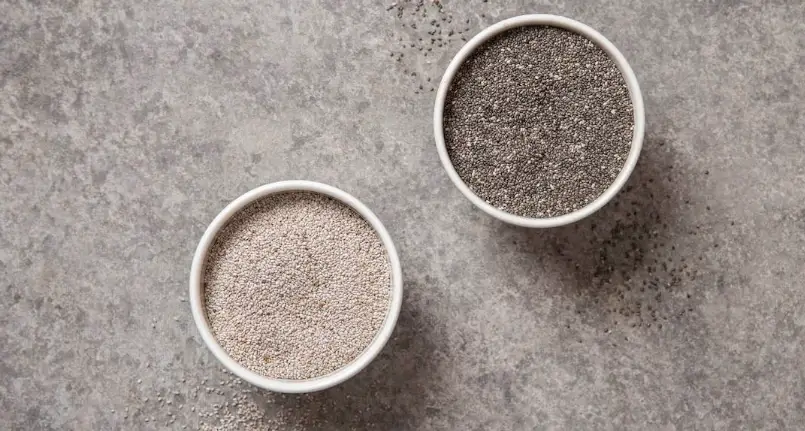Chia seeds are small seeds that are flat and oval in shape, and have a shiny, smooth texture .
They can be black or white , and both are made from a plant called Salvia Hispanica , which belongs to the mint family and is native to Central America and southern Mexico.
Differences between white and black seeds
The differences between these types of seeds are only and exclusively on a chromatic level . As far as nutritional values , benefits and uses are concerned , however, white or black seeds are equivalent .
The choice, therefore, is dictated only by which predominant color you want to give to your dishes, given that black chia seeds add greater chromatic contrast to the dishes they enrich, while white ones blend in more easily.
Nutritional values and components
The nutrients in 100 grams of Chia seeds are:
- Calories : 486,
- Water: 6%,
- Protein : 16.5 grams,
- Carbs: 42.1 grams,
- Sugar : 0 grams,
- Fiber: 34.4 grams,
- Fat: 30.7 grams,
- Saturated : 3.33 grams,
- Monounsaturated : 2.31 grams,
- Polyunsaturated : 23.67 grams,
- Omega-3 : 17.83 grams,
- Omega-6 : 5.84 grams.
Chia seeds are also gluten -free , therefore suitable for those suffering from celiac disease .
Carbohydrates and fiber
Chia seeds are an excellent source of carbohydrates and more than 80% of their content is in the form of fiber .
28 grams of chia seeds boast 11 grams of fiber , an amount that contributes significantly to reaching the recommended reference daily allowance for women and men, set at 25 and 38 grams per day, respectively.
These fibers are 95% insoluble , a type associated with a reduced risk of diabetes . When chia seeds are placed in water or other liquids, their fibers absorb up to 10-12 times their weight and the seeds turn into a gelatinous mass.
Fats
One of the unique characteristics of chia seeds is their high content of omega-3 fatty acids which makes them the largest plant source of this element.
Specifically, about 75% of the fat in chia seeds is omega-3 alpha-linolenic acid , while about 20% is omega-6 fatty acids.
According to several studies, a high intake of omega-3 compared to omega-6 would reduce the level of inflammation in the body. It would also decrease the risk of some chronic conditions, most notably heart disease .
Protein
Chia seeds contain 19% protein . This concentration is similar to other seeds but much higher than most grains . Notably, these seeds offer all nine essential amino acids and are therefore a high-quality plant protein.
A high protein intake brings with it several benefits and is often associated with a greater feeling of satiety after meals and a consequent reduced food intake .
Minerals
Chia seeds provide high amounts of many minerals . These are the ones present in the greatest concentration.
- Manganese : stimulates metabolism , growth and development.
- Phosphorus : contributes to the maintenance of bone and tissue health.
- Copper : important for cardiovascular health .
- Selenium : generates antioxidant properties .
- Iron : A component of hemoglobin in red blood cells , iron is involved in transporting oxygen throughout the body.
- Magnesium : plays a fundamental role in many physiological processes.
- Calcium : essential for strengthening bones, muscles and nerves .
The absorption of some minerals, such as iron and zinc , can be reduced due to the phytic acid content in chia seeds.
Benefits
Chia seeds bring various benefits to the body .
The most relevant are: promotion of skin , bone and muscle health , support of the cardiovascular and digestive systems , reduction of aging , acceleration of metabolism and increase of energy , promotion of dental health and decrease the risk of diabetes .
Here are the benefits of pumpkin seeds instead .
How they are eaten
Chia seeds are very small, crunchy and have a rather neutral and not at all unpleasant taste , therefore they can be combined with various dishes without altering their flavour. One use for them could be as an additional ingredient in puddings, mousses, smoothies, yoghurts or porridge . They can also be used in baked goods such as muffins, cakes, breads and flatbreads , sprinkled on salads or meats , or mixed with soups, stews , pasta, rice , quinoa and legumes .
Thanks to their ability to absorb liquids and turn into gels, they can also be used to thicken sauces or as an egg substitute .
Usually white chia seeds are chosen to enrich dishes with light colors and light characteristics, while on the contrary the black ones for more important foods . However, these are subjective choices, given that there is no substantial difference between the two varieties.
Chia seeds are still not very common in Italy compared to other seeds but they can be found in shops specializing in organic or fair trade foods , in herbalist’s shops or online.




